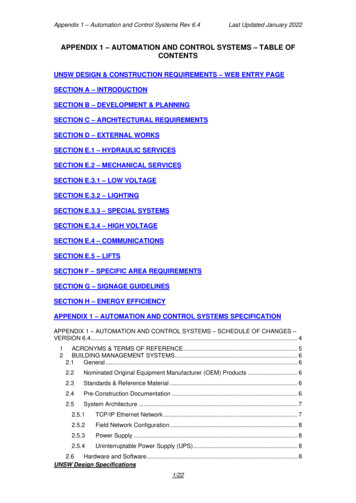
Transcription
APPENDIX BPANEL MEMBER DETAILED PIRT SUBMITTALS FOR OPERATIONSThe INEEL submittal is provided in Appendix B.1 (pages B-2 through B-48).The ORNL submittal is provided in Appendix B.2 (pages B-49 through B-96).The SNL submittal is provided in Appendix B.3 (pages B-97 through B-143).B-1
Appendix B.1Detailed PIRT Submittal by the INEEL Panel MemberD. A. PettiB-2
TRISO Fuel PIRT: OperationsLife CyclePhaseFactor, Characteristic orPhenomenonOperationsFuel elementTemperatureImportance Rank and RationaleRank: HRationale: (I will assume that by element we meanthe matrix material of the fuel pebble or compact.)Temperature drives diffusion and mobility offission products in all components of the fuelelement. Semi-empirical models exist to describethe behavior in the matrix material.DefinitionLocal temperature in the fuel elementKnowledge Level and RationaleLevel: 8Rationale:Additional DiscussionB-3Remedy for Inadequate Knowledge/IssueClosure CriteriaRemedy:Closure Criterion:
Life CyclePhaseFactor, Characteristic orPhenomenonOperationsFuel elementFast fluenceImportance Rank and RationaleRank: MRationale: Shrinkage of the matrix material is afunction of fast fluence. Radiation damage mayprovide trapping sites to retain fission products inthe matrix materialDefinitionAccumulated fast neutron fluence greater than 0.18 MeVKnowledge Level and RationaleLevel: 5Rationale:Additional DiscussionB-4Remedy for Inadequate Knowledge/IssueClosure CriteriaRemedy:Closure Criterion:
Life CyclePhaseFactor, Characteristic orPhenomenonOperationsFuel elementPower densityImportance Rank and RationaleRank: LRationale: More important in the particles than inthe matrix/element per se. Thermal gradient acrosspebbles is fairly low.DefinitionPower per pebble or compact (W)Knowledge Level and RationaleLevel: 6Rationale:Additional DiscussionB-5Remedy for Inadequate Knowledge/IssueClosure CriteriaRemedy:Closure Criterion:
Life CyclePhaseFactor, Characteristic orPhenomenonOperationsFuel elementTemperature differenceImportance Rank and RationaleRank: MRationale: For pebble beds, low temperaturedifferences are expected. Temperature gradientsdrive the amoeba effect.DefinitionTemperature between center or centerline and surface in CKnowledge Level and RationaleLevel: 7Rationale: Correlations exist to describe amoebaeffectAdditional DiscussionB-6Remedy for Inadequate Knowledge/IssueClosure CriteriaRemedy:Closure Criterion:
Life CyclePhaseFactor, Characteristic orPhenomenonOperationsFuel elementTemperature-time historiesImportance Rank and RationaleRank: HRationale: Fission product release from the fueldepends on the time/temperature history of eachlayer in the fuel element and models includeexplicit temperature dependence and thus thiseffect can be evaluated.DefinitionLocal temporal temperature of fuel element over its lifetimeKnowledge Level and RationaleLevel: 7Rationale:Additional DiscussionB-7Remedy for Inadequate Knowledge/IssueClosure CriteriaRemedy:Closure Criterion:
Life CyclePhaseFactor, Characteristic orPhenomenonOperationsFuel elementCondensed phase diffusionImportance Rank and RationaleRank: HRationale: Transport of metallic fission productsthrough the matrix is probably via surfacediffusion with some trapping or sorption effects.DefinitionInter-granular diffusion and/or intragrannular solid-state diffusionKnowledge Level and RationaleLevel: 5Rationale: Diffusion and sorption models havebeen used to characterize solid fission productdiffusion through the matrix material. Parametersfor sorption exist for U.S. matrix material for Cs,Sr and other fission products. For German matrixmaterial, effective diffusion coefficients exist forAg, Cs, and Sr. New data may be needed formatrix material because of different startingmaterials used to make the matrix.Additional DiscussionB-8Remedy for Inadequate Knowledge/IssueClosure CriteriaRemedy:Closure Criterion:
Life CyclePhaseFactor, Characteristic orPhenomenonOperationsFuel elementGas phase diffusionImportance Rank and RationaleRank: MRationale: Probably the mechanism that bestdescribes the transport of fission gases through thematrix material. The matrix does not hold upfission gases significantly.DefinitionDiffusion of gaseous fission products through layer (Knudsen and bulk diffusion through pore structure,and pressure driven permeation through structure)Knowledge Level and RationaleLevel: 7Rationale:Additional DiscussionB-9Remedy for Inadequate Knowledge/IssueClosure CriteriaRemedy:Closure Criterion:
Life CyclePhaseFactor, Characteristic orPhenomenonOperationsFuel elementCorrosion by coolant impuritiesImportance Rank and RationaleRank: MRationale: Corrosion by moisture or oxygen canoxidize pebble and any exposed kernelscontributing to the source term. Allowableconcentrations have been established to minimizethis effort.DefinitionCorrosion of the fuel element surface by part per million level of gaseous impurities in the heliumcoolant.Knowledge Level and RationaleLevel: 6Rationale: Impurities levels have been establishedto minimize corrosion.Additional DiscussionB-10Remedy for Inadequate Knowledge/IssueClosure CriteriaRemedy:Closure Criterion:
Life CyclePhaseFactor, Characteristic orPhenomenonOperationsKernelCO productionImportance Rank and RationaleRank: H for UO2, L for UCORationale: CO is predicted to form as a result ofthe reaction of excess oxygen released from fissionreacting with buffer carbon. It has been measuredin UO2 particles. It is a pressure source term forstructural modeling and can drive kernel migrationand SiC corrosion (in the case of a failed IPyC).DefinitionFormation of CO from excess oxygen released in fissionKnowledge Level and RationaleLevel: 8 for UO2, 5 for UCORationale: Measurements on CO in coated UO2particles have been made up to 10% burnup. Nosimilar measurements have been made on UCO.Additional DiscussionB-11Remedy for Inadequate Knowledge/IssueClosure CriteriaRemedy:Closure Criterion:
Life CyclePhaseFactor, Characteristic orPhenomenonOperationsKernelBurnupImportance Rank and RationaleRank: HRationale: Burnup determines the concentration offission products, especially those like Pd that havebeen shown to attack the SiC. The higher theconcentration of aggressive fission products, thehigher the chance of fuel particle failure andfission product release. In addition, burnupinfluences fuel swelling and the microstructure ofthe kernel as a result of fission gas generation,transport to the grain boundaries and the formationof interconnected porosity, which allows the gasesto escape the kernel. Thus, fission gas releasefrom the kernel depends on burnup.DefinitionFission of initial metal atomsKnowledge Level and RationaleLevel: 7Rationale: Large database exists for UO2 coatedparticles up to 10% FIMAAdditional DiscussionB-12Remedy for Inadequate Knowledge/IssueClosure CriteriaRemedy:Closure Criterion:
Life CyclePhaseFactor, Characteristic orPhenomenonOperationsKernelKernel swellingImportance Rank and RationaleRank: LRationale: Kernel swelling is known to occur in allfuels with values that scale linearly with burnup.Swelling is calculated to be quite high at the highburnups proposed for some coated particle designs,but they are outside the PBMR burnup envelope.However, the buffer does accommodate theswelling to some degree and ameliorate anypotential deleterious effects.DefinitionVolumetric expansion of kernel resulting from fissioningKnowledge Level and RationaleLevel: 6Rationale:Additional DiscussionB-13Remedy for Inadequate Knowledge/IssueClosure CriteriaRemedy:Closure Criterion:
Life CyclePhaseFactor, Characteristic orPhenomenonOperationsKernelMicrostructure changesImportance Rank and RationaleRank: LRationale: Microstructural changes do occur in thekernel however at very high burnups the completedestruction of the crystal structure of kernel isoften seen. Some changes are empirically capturedin fission product release models via a burnupdependence. The influence on release from thefuel particle is low since these changes do notaffect the coatings [in a properly designedparticle]. Grain growth is not expected to occur attypical operating temperatures.DefinitionChange in structure in kernel with burnup, including fission gas bubbles, grain growth and graindisintegrationKnowledge Level and RationaleLevel: 6Rationale: The experience base from testing ofUO2 to 10% FIMA does not suggest that this iscritical.Additional DiscussionB-14Remedy for Inadequate Knowledge/IssueClosure CriteriaRemedy:Closure Criterion:
Life CyclePhaseFactor, Characteristic orPhenomenonOperationsKernelFission product chemical formImportance Rank and RationaleRank: HRationale: Volatility of fission products is afunction of their chemical form. The chemicalform is an important initial condition for transportthrough the layers.DefinitionChemical speciation of fission products as a function of burnup and temperatureKnowledge Level and RationaleLevel: 7Rationale: Chemical form of fission products inoxide and oxycarbide fuels has been extensivelyinvestigated thermodynamically. Experimentalconfirmation of the chemical forms is notcomplete.Additional DiscussionB-15Remedy for Inadequate Knowledge/IssueClosure CriteriaRemedy:Closure Criterion:
Remove one line aboveLife CycleFactor, Characteristic orPhasePhenomenonOperationsKernelBuffer interactionImportance Rank and RationaleRank: MRationale: Mechanical interactions could lead tofailure of the buffer layer. But buffer is a sacrificiallayer anyway. Chemical interaction of UO2 withthe buffer forms a rind of UC2 at the interface.DefinitionMechanical and chemical interactions between the kernel and buffer, e.g., chemical reactions at interfaceand displacement of buffer by kernel growth.Knowledge Level and RationaleLevel: 6Rationale: Mechanical interaction with the bufferhas never been seen in high-density UO2 kernels.UC2 rind has been observed.Additional DiscussionB-16Remedy for Inadequate Knowledge/IssueClosure CriteriaRemedy:Closure Criterion:
Life CyclePhaseFactor, Characteristic orPhenomenonOperationsKernelKernel migration (fueldependent)Importance Rank and RationaleRank: M UO2 and L UCORationale: Kernel migration is reasonably wellknown. In UO2 pebbles, power densities arerestricted to limit the temperature gradient and thusthe migration that can occur so that migration isnot an important failure mechanism. In UCO fuel,the chemistry of the fuel prevents significantmigration from occurring.DefinitionTransport of carbon down the temperature gradientKnowledge Level and RationaleLevel: 8Rationale: In UO2, kernel migration has beenmeasured and correlations exist to describe thebehavior that depends strongly on the temperatureand temperature gradient in the particle.Additional DiscussionB-17Remedy for Inadequate Knowledge/IssueClosure CriteriaRemedy:Closure Criterion:
Life CyclePhaseFactor, Characteristic orPhenomenonOperationsKernelFission product generationImportance Rank and RationaleRank: HRationale: Yield determines the fission productconcentration in the kernel and thus the startingpoint for source term. It is well known and wellcharacterized.DefinitionYield of fission products from uranium and plutonium fissionKnowledge Level and RationaleLevel: 9Rationale:Additional DiscussionB-18Remedy for Inadequate Knowledge/IssueClosure CriteriaRemedy:Closure Criterion:
Life CyclePhaseFactor, Characteristic orPhenomenonOperationsKernelTemperature gradientImportance Rank and RationaleRank: LRationale: High conductivity of UO2 and UCOresults in modest temperature gradients across thekernel (3 to 5 K across the 500 microns).DefinitionTemperature gradient across the kernelKnowledge Level and RationaleLevel: 6Rationale: Can calculate reasonably well evenaccounting for change in kernel physical form asburning increasesAdditional DiscussionB-19Remedy for Inadequate Knowledge/IssueClosure CriteriaRemedy:Closure Criterion:
Life CyclePhaseFactor, Characteristic orPhenomenonOperationsKernelIsotopic half lifeImportance Rank and RationaleRank: MRationale: Half-life is well known and its influenceon short-lived fission gas release is adequatelyaccounted for in the models. For the safetysignificant isotopes, the half-life is even lessimportant since they either reach an equilibrium inthe fuel or they do not decay significantly duringoperation.DefinitionThe time lapse during which a mass of a particular isotope loses half of its radioactivityKnowledge Level and RationaleLevel: 9Rationale:Additional DiscussionB-20Remedy for Inadequate Knowledge/IssueClosure CriteriaRemedy:Closure Criterion:
Life CyclePhaseFactor, Characteristic orPhenomenonOperationsBuffer layerPressureImportance Rank and RationaleDefinitionGas pressure generated in the void volume associated with the buffer layerKnowledge Level and RationaleRank: HLevel: 7 for UCO and 6 for UO2 at high burnupRationale: Fission gas and CO (for UO2 only)contribute to the gas pressure in the particle, whichis important in evaluating the structural integrity ofthe TRISO coating.Rationale: Fission gas yield and thermodynamicestimates of CO production are used to analyticallyestimate the pressure. Data on CO release fromUO2 particles exist at low burnup ( 10% FIMA)and a range of temperatures. At high burnups ( 10% FIMA) in UO2 fuel, there is a need to measureCO release by crushing particles.Additional DiscussionB-21Remedy for Inadequate Knowledge/IssueClosure CriteriaRemedy: Will be measured by Europeans in theircoated particle fuel programClosure Criterion:
Life CyclePhaseFactor, Characteristic orPhenomenonOperationsBuffer layerShrinkageDefinitionRadiation or otherwise induced dimensional changeImportance Rank and RationaleKnowledge Level and RationaleRank: MLevel: 6Rationale: Differential shrinkage of the bufferbecause of temperature gradients can lead tostresses in the layer large enough to cause crackingof the layer. These cracks can result in shortcircuit diffusion of fission products to the TRISOcoating.Rationale: Modeling of this phenomenon isongoing at INEEL.Additional DiscussionB-22Remedy for Inadequate Knowledge/IssueClosure CriteriaRemedy: Await modeling work from DOE/INEELprogramClosure Criterion:
Life CyclePhaseFactor, Characteristic orPhenomenonOperationsBuffer layerCrackingDefinitionShrinkage cracks produced in layer during operationImportance Rank and RationaleKnowledge Level and RationaleRank: HLevel: 5Rationale: Cracking can occur as a result of highstresses produced via differential shrinkage of thebuffer during irradiation. Some model calculationslike STRESS3 suggest that kernel-buffermechanical interaction can lead to high stresses inthe buffer and hence cracking. These cracks canresult in short-circuit diffusion of fission productsto the TRISO coating.Rationale: Modeling of this phenomenon isongoing at INEEL.Additional DiscussionB-23Remedy for Inadequate Knowledge/IssueClosure CriteriaRemedy: Await modeling work from DOE/INEELprogramClosure Criterion:
Life CyclePhaseFactor, Characteristic orPhenomenonOperationsBuffer layerCarbonyl vapor speciesImportance Rank and RationaleRank: MRationale: Unknown if such species are at allimportant.DefinitionM-CO species partial pressuresKnowledge Level and RationaleLevel: 3Rationale:Additional DiscussionB-24Remedy for Inadequate Knowledge/IssueClosure CriteriaRemedy:Closure Criterion:
Life CyclePhaseFactor, Characteristic orPhenomenonOperationsBuffer layerTemperature gradientImportance Rank and RationaleRank: HRationale: The temperature difference across thelayer (which is directly related to the powerproduced in the particle) can determine thestructure integrity of the layer and the thermaldiffusion (Soret effect) of some fission productsand oxygen and carbon in the kernel. The amoebaeffect is one example. Pd and Ag migration in thefuel particle is also thought to be driven bygradients. Modeling of these phenomena is at afundamental level and is just beginning. Empiricalcorrelations exist to be used in fuel design.DefinitionTemperature difference across the buffer layerKnowledge Level and RationaleLevel: 5Rationale: Can estimate thermal gradient to someextent. The formation of gaps complicates theanalysis and can lead to higher gradients.Additional DiscussionB-25Remedy for Inadequate Knowledge/IssueClosure CriteriaRemedy:Closure Criterion:
Life CyclePhaseFactor, Characteristic orPhenomenonOperationsBuffer layerCondensed phase diffusionImportance Rank and RationaleRank: MRationale: Probably the mechanism of transport ofthe metallic fission products through this layer.However, in many cases the buffer cracks whichprovides a short circuit path for fission producttransport.DefinitionInter granular diffusion and/or intragrannular solid state diffusionKnowledge Level and RationaleLevel: 5Rationale: Simple gas phase mass transportcoefficients can be calculated. Sorptive effects ofthe buffer are less well defined.Additional DiscussionB-26Remedy for Inadequate Knowledge/IssueClosure CriteriaRemedy:Closure Criterion:
Life CyclePhaseFactor, Characteristic orPhenomenonOperationsBuffer layerGas phase diffusionDefinitionDiffusion of gaseous fission products through layer (Knudsen and bulk diffusion through pore structure,and pressure driven permeation through structure).Importance Rank and RationaleKnowledge Level and RationaleRank: MRationale: Probably the most significantmechanism responsible for gaseous fission producttransport through the buffer. However thestructure of the buffer changes significantly withfast fluence, which makes the detailed modeling ofsuch transport very difficult. Usually models donot account for transport in this layer. If the buffercracks (which can occur at high power densities)then fast diffusion to the IPyC layer occurs.Level: 5Rationale: Knudsen diffusion estimates suggestrapid diffusion compared to other layers. Diffusionthrough cracks suggests very rapid diffusion.Additional DiscussionB-27Remedy for Inadequate Knowledge/IssueClosure CriteriaRemedy:Closure Criterion:
Life CyclePhaseFactor, Characteristic orPhenomenonOperationsBufferRecoil effectsImportance Rank and RationaleRank: MRationale: Recoil ranges of fission fragments canbe on the order of 5-10 µm which is 5-10% of thebuffer layer.DefinitionBuffer damage arising from capture of high-energy fission productsKnowledge Level and RationaleLevel: 7Rationale: Can be calculated using recoil modelsAdditional DiscussionB-28Remedy for Inadequate Knowledge/IssueClosure CriteriaRemedy:Closure Criterion:
Life CyclePhaseFactor, Characteristic orPhenomenonOperationsInner PyC layerRadiation induced creepDefinitionStrain release as a result of radiation induced dimensional changeImportance Rank and RationaleKnowledge Level and RationaleRank: HLevel: 5Rationale: Very important to know the radiationinduced creep rate for IPyC. It counteracts theshrinkage and thus determines tensile stress in thelayer. High tensile stresses threaten layer integrityand the integrity of the SiC layer as well via theformation of a stress concentration. It has beenshown to be the most important parameter instructural modeling (see refs. 1 and 2)Rationale: Creep values range widely in theliterature (see ref. 3). New more accuratemeasurements are needed.Remedy for Inadequate Knowledge/IssueClosure CriteriaRemedy: Will be measured in new DOE NERIprogram. (see ref 4)Closure Criterion:Additional Discussion1. G. K. Miller et al., “Statistical Approach and Benchmarking for Modeling of Multi-dimensional Behavior in TRISO-coated Fuel Particles,” J. NuclearMaterials, forthcoming.2. G.K. Miller et al., 2001, “Consideration of the Effects on Fuel Particle Behavior from Shrinkage Cracks in the Inner Pyrocarbon Layer,” Journal of NuclearMaterials, Vol. 295, pp. 205-212.3. D. A. Petti et al., “Development of Improved Models and Design for Coated Particle Gas Reactor Fuels,” 2002 Annual Report, INEEL/EXT-02-01493, Nov.2002.4. L. L. Snead and D. A. Petti, “Improving the Integrity of Coated Particle Fuels: Measurements of Constituent Properties of SiC and ZrC, Effects of Irradiationand Modeling,” NERI Proposal, April 2002.B-29
Life CyclePhaseFactor, Characteristic orPhenomenonOperationsInner PyC layerFast fluenceImportance Rank and RationaleRank: HRationale: Fast fluence affects shrinkage andswelling of the layer. This dimensional changeinduces stresses in the IPyC layer which if highenough can cause failure.DefinitionAccumulated fast neutron fluence greater than 0.18 MeVKnowledge Level and RationaleLevel: 8Rationale: Shrinkage of IPyC layer is a strongfunction of fast fluence and anisotropy and is wellknown.Additional DiscussionB-30Remedy for Inadequate Knowledge/IssueClosure CriteriaRemedy:Closure Criterion:
Life CyclePhaseFactor, Characteristic orPhenomenonOperationsInner PyC layerDimensional changeImportance Rank and RationaleRank: HRationale: Shrinkage rate under irradiation iscritical to understanding structural response ofIPyC and TRISO coating. The shrinkage isreasonably well known.DefinitionUnrestrained radial and tangential changes with fast fluenceKnowledge Level and RationaleLevel: 7Rationale: Shrinkage of IPyC layer is a strongfunction of fast fluence and anisotropy and is wellknown.Additional DiscussionB-31Remedy for Inadequate Knowledge/IssueClosure CriteriaRemedy:Closure Criterion:
Life CyclePhaseFactor, Characteristic orPhenomenonOperationsInner PyC layerAnisotropyDefinitionOperation-induced (thermal radiation) change in grain orientation along principal directions asmeasured by the BAFImportance Rank and RationaleKnowledge Level and RationaleRank: HRationale: The degree of anisotropy is the criticalmeasure of dimensional stability of the PyC underirradiation. If the PyC has too high an anisotropy,the differential shrinkage under irradiation willproduce tensile stress in the PyC that can cause itto fail. If the other layers remain intact then littlefission product release is expected. However, if theSiC is defective, then some fission product releasewill occur during normal operation and under offnormal conditions. The technical basis for the PyCBAF is found in Reference 1.Level: 8 (German), 6 (U.S.)Rationale: There is a significant amount ofinformation in the literature that outlines theimportance of anisotropy to performance of PyCunder irradiation. (see ref. 2). The ability toaccurately measure the BAF has been a problem inU.S. fuel but not in German fuel, which is thereason for the difference in ranking above. (see ref4) The new DOE AGR program (see ref. 5) willattempt to develop new more accurate methods tomeasure anisotropy.Remedy for Inadequate Knowledge/IssueClosure CriteriaRemedy: Await results from DOE AGR program.Closure Criterion:Additional Discussion1. NP-MHTGR Fuel Product Specification Basis Report, CEGA-000396, June 19922. D.G., Martin, April 2000, Pyrocarbon in High Temperature Nuclear Reactor in Irradiation Damage in Graphite due to Fast Neutrons in Fission and FusionSystems, Report IAEA-TECDOC-1154.3. D. A. Petti et al., “Key Differences in the Fabrication, Irradiation, and Safety Testing of U.S. and German TRISO-coated Particle Fuel and Their Implicationson Fuel Performance,” INEEL/EXT-02-00300, June 2002.4. Technical Program Plan for the Advanced Gas Reactor Fuel Development and Qualification Program, ORNL/TM-2002/262, Nov. 2002B-32
Life CyclePhaseFactor, Characteristic orPhenomenonOperationsInner PyC layerCrackingImportance Rank and RationaleRank: HRationale: Cracking in the IPyC as a result of hightensile stresses in the layer can lead to a stressconcentration in the SiC layer that can causefailure and thus fission product release. Fissionproducts are often found near cracks (as a result ofthe fast diffusion path to the SiC layer).DefinitionLengths, widths, and numbers of cracks produced in layer during operationKnowledge Level and RationaleLevel: 6Rationale:Additional DiscussionB-33Remedy for Inadequate Knowledge/IssueClosure CriteriaRemedy:Closure Criterion:
Life CyclePhaseFactor, Characteristic orPhenomenonOperationsInner PyC layerDebondingImportance Rank and RationaleRank: MRationale: Debonding can lead to stressconcentrations in the SiC layer near the debondingpoint and cause failure of the SiC layer and fissionproduct release.DefinitionSeparation of PyC layer from SiC layerKnowledge Level and RationaleLevel: 5Rationale: Debonding of the IPyC layer is oftenseen in U.S. fuel and rarely if ever in German fueldue to the difference in the interface between thelayers. Key issue is the bond strength between theIPyC and SiC.Additional DiscussionB-34Remedy for Inadequate Knowledge/IssueClosure CriteriaRemedy:Closure Criterion:
Life CyclePhaseFactor, Characteristic orPhenomenonOperationsInner PyC layerCondensed phase diffusionImportance Rank and RationaleRank: HRationale: Probably the mechanism of transport ofthe metallic fission products through this layer,along crystallite edges and between graphite layersetc.DefinitionInter granular diffusion and/or intragrannular solid-state diffusionKnowledge Level and RationaleLevel: 7Rationale: Effective diffusion coefficients havebeen measured for metallic fission products (Cs,Ag) through IPyCAdditional DiscussionB-35Remedy for Inadequate Knowledge/IssueClosure CriteriaRemedy:Closure Criterion:
Life CyclePhaseFactor, Characteristic orPhenomenonDefinitionOperationsInner PyC layerGas phase diffusionDiffusion of gaseous fission products through layer ( Knudsen and bulk diffusion through pore structure,and pressure driven permeation through structure)Importance Rank and RationaleRank: HRationale: May be the mechanism responsible forthe transport of gaseous fission products throughthe IPyC layer.Knowledge Level and RationaleLevel: 7Rationale: Effective diffusion coefficients exist fornoble gases through the IPyC. Detailed models forgas phase diffusion that take into account explicitlythe porosity and void structure do not exist.Additional DiscussionB-36Remedy for Inadequate Knowledge/IssueClosure CriteriaRemedy:Closure Criterion:
Life CyclePhaseFactor, Characteristic orPhenomenonOperationsSiC LayerKernel interaction with SiClayerImportance Rank and RationaleRank: MRationale: Kernel migration is not a major failuremechanism in UCO fuels. In UO2 fuels in pebblebeds like PBMR, the limits imposed on power perparticle in the design limit migration.DefinitionKernel migration (amoeba effect)Knowledge Level and RationaleLevel: 8Rationale: Kernel migration has been measured incoated particle fuel with UO2 kernels. Nosignificant migration has been observed in UCO.It is a function of temperature and temperaturegradient.Additional DiscussionB-37Remedy for Inadequate Knowledge/IssueClosure CriteriaRemedy:Closure Criterion:
Life CyclePhaseFactor, Characteristic orPhenomenonOperationsSiC LayerFission product corrosionImportance Rank and RationaleRank: HRationale: Fission product attack of the SiC layershas been observed in many irradiationexperiments. The attack is thought to be a functionof concentration of the fission product (burnup),temperature and temperature gradient across theparticle (power density of the particle).DefinitionAttack of layer by fission products, e.g., PdKnowledge Level and RationaleLevel: 6Rationale:Additional DiscussionB-38Remedy for Inadequate Knowledge/IssueClosure CriteriaRemedy:Closure Criterion:
Life CyclePhaseFactor, Characteristic orPhenomenonOperationsSiC LayerHeavy metal attackImportance Rank and RationaleRank: LRationale: This was a problem in early coatedparticle fuel because during SiC formation in thecoater, chlorine decomposed from the MTS used tomake the SiC would attack the kernel and formuranium chloride which is volatile and wouldbecome trapped in the SiC layer during the CVDprocess. Subsequent irradiation of the fuel causesthe uranium in the SiC layer to fission damagingthe layer.DefinitionDamage to layer due to fissioning of heavy metals dispersed in the layerKnowledge Level and RationaleLevel: 6Rationale: Modern fabrication methods limit thiseffect to very low levels.Additional DiscussionB-39Remedy for Inadequate Knowledge/IssueClosure CriteriaRemedy:Closure Criterion:
Life CyclePhaseFactor, Characteristic orPhenomenonOperationsSiC LayerCrackingImportance Rank and RationaleRank: HRationale: Cracking of the SiC layer will allowmetallic fission products to be released from thecoated particle. (Fission gases will still be retainedif the OPyC is intact).DefinitionLengths, widths and numbers of cracks produced in layer during operationKnowledge Level and RationaleLevel: 7Rationale:Additional DiscussionB-40Remedy for Inadequate Knowledge/IssueClosure CriteriaRemedy:Closure Criterion:
Life CyclePhaseFactor, Characteristic orPhenomenonOperationsSiC LayerCondensed phase diffusionImportance Rank and RationaleRank: HRationale: Surface or grain boundary diffusion isprobably the mechanism responsible for Cs and Srtransport through the SiC layer. Activationenergies in coated particle fuels are similar to thatexpected for grain boundary diffusion ( equal tothe heat of vaporization for the fission product).DefinitionInter granular diffusion and/or intragrannular solid-state diffusionKnowledge Level and RationaleLevel: 7Rationale: Effective diffusion coefficients havebeen measured for fission products of interest.Additional DiscussionB-41Remedy for Inadequate Knowledge/IssueClosure CriteriaRemedy:Closure Criterion:
Life CyclePhaseFactor, Characteristic orPhenomenonDefinitionOperationsSiC LayerGas phase diffusionDiffusion of gaseous fission products through layer ( Knudsen and bulk diffusion through pore structure,and pressure driven permeation through structure)Importance Rank and RationaleRank: HRationale: Probably the mechanism responsible forgaseous fission product transport through the layer.Knowledge Level and RationaleLevel: 7Rationale: Models have not been developed thatcorrelate the observ
Rank: H for UO2, L for UCO Level: 8 for UO2, 5 for UCO Remedy: Rationale: CO is predicted to form as a result of the reaction of excess oxygen released from fission reacting with buffer carbon. It has been measured in UO2 particles. It is a pressure source term for structural modeling and can drive kernel migration











